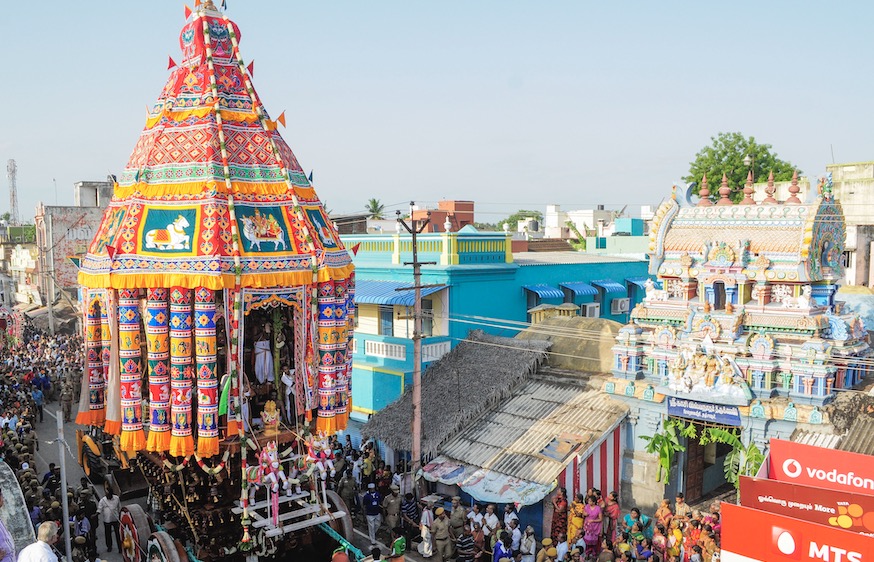TAMIL NADU’S FABULOUS NEW TEMPLE CHARIOT
______________________
After a hundred-year hiatus, an exquisite vehicle for Siva is carved for Thanjavur’s
Brihadeeswarar Temple
______________________
An historic and joyous parade: Rising to fifty feet, the new main chariot and five other chariots are taken in procession through the city of Thanjavur, India, on April, 2015
ALL PHOTOS: MU DEVRAYAN
Ancient tradition renewed: The magnificent Big Temple at night
A PRIL 29, 2015, WAS AN HISTORIC DAY in Tamil Nadu. For the first time in a century, the 1,000-year-old Brihadeeswarar Temple in Thanjavur, popularly known as the “Big Temple,” held its chariot festival. Most large, active temples hold this important event annually. But the old chariot at the Big Temple—declared a world monument by UNESCO and treated as an archeological site—was damaged one hundred years ago, and the festival was abandoned. With the renewal of regular pujas in recent times, demand grew to reinstate the chariot festival and build a new chariot. In 2012 the government allocated US$75,000 for the project. Thirty craftsmen worked for fifteen months to complete the masterpiece, using 1,175 cubic feet of wood from the Veppanthattai area and five tons of metal parts and ornaments. The base is over sixteen feet tall and weighs fifty tons,
It was a joyous day. Special pujas commenced early in the morning, after which the processional Deities were brought to the staging camp on West Main Street. Amid Vedic chanting, 100,000 devotees joined to help pull the chariot, which, with its upper tower, rises to nearly fifty feet. A total of six chariots with different Deities were in the parade. One government employee summed up the day’s feelings, “I am thrilled and filled with pride today; the chariot festival has resumed in my lifetime.”
INSIGHTS FROM A HINDU SCHOLAR
HINDUISM TODAY gained these observations from Sivachariyar Sabharathnam, a renowned scholar of the Saiva Agamas. He says, “The properly constructed chariot of a temple incorporates within its whole structure all the main parts and sub-parts of the temple. It includes all the temple’s shrines and the vibrant presence of all its Deities. As such, it is called chala-alaya, the ‘moving temple.’ When it is ceremonially worshiped according to Agamic instructions, it becomes charged with the presence of all three worlds and their divine forces.
“The chariot festival is the most important event during the course of any brahmotsava (grand festival). It is intended to re-establish and rejuvenate the solidarity of the people of all divisions, reactivate welfare and harmony among all living beings and invoke the unhindered flow of essential natural resources, such as timely rainfall, crops and more.
“So, naturally, devotees living not only in Thanjavur but also in all other parts of Tamil Nadu eagerly awaited the renewal of this grand and splendid event. Everyone was elated and filled with divine bliss when the perfectly redesigned chariot was sent on its rhythmic procession through main streets of Thanjavur, the city of the Periya Koyil, or ‘Big Temple.’ In 1010 CE, at the time of the great king Rajaraja Chola, who built this temple, the festival was established as an uttama-mahotsava, a ‘superior celebration,’ lasting for 17 days.
Thousands of devotees converge to pull six chariots during the April, 2015 (new chariot is at the top of the photo)
“We should all offer deep appreciation and high praise for the work done by Sthapati Varadarajan of Arumbavur and his entire team. The new chariot was meticulously designed and is extraordinarily beautiful. On the sides and elevations he fixed only the images and icons of various Deities as recommended in our scriptures, the Saiva Agamas. The chariot is studded with 380 images, all exquisitely carved according to the system of proportionate measurements prescribed by the Silpa Sastras.”
THE CHARIOT’S MAGNIFICANT TEMPLE HOME
The monumental Brihadeeswarar Siva temple in Thanjavur celebrated its 1,000th birthday in 2010, having been built by Emperor Raja Raja Chola I in 1010! It is one of the three great Chola temples of Tamil Nadu designated by as World Heritage Sites by UNESCO. Its vimanam, or central tower, is 216 feet high, and its cap stone weighs 80 tons. The 15-foot-tall monolithic Sivalingam in the sanctum is among the largest in the world, so large that the vimanam had to be built around it. As a hub of worship, culture, music, dance and scholarship, it was a driving force behind a robust, wealthy, local economy. During the plunder of India’s economy by the British, the temple declined to the point of being abandoned and was used as a barracks for British soldiers. A kumbhabhishekam (reconsecration) was performed most recently in 1997, following extensive renovation. It has now become an international cultural attraction.
These giant colorful chariot wheels, created by a separate team of craftsmen
The chariot base, covered with carvings; the starting point for the festival a staging area at West Main Street
